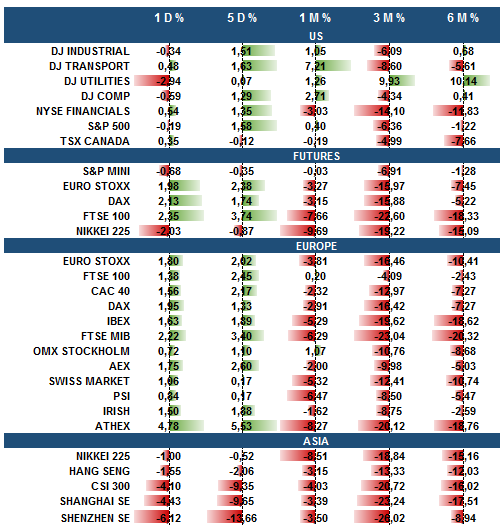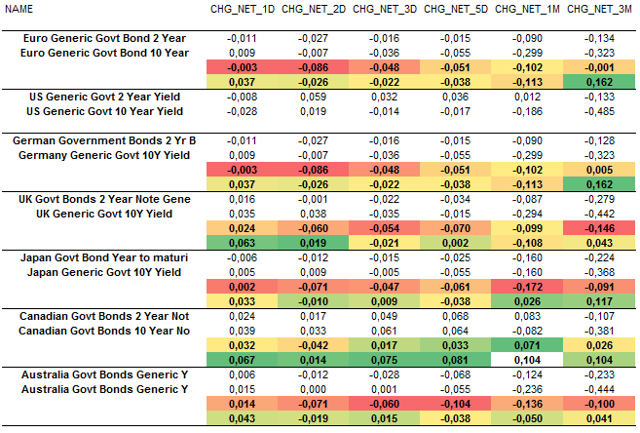http://myndoscapital.com/global-markets-weekly/
US: The highlight of the week will be Friday with the February payroll report. We expect a print of 185K, up from 151K in January. This should keep the unemployment rate at 4.9%. We expect hourly earnings to be 0.2%m/m and 2.6%y/y (from 0.5%m/m and 2.5%y/y for January). The other big data point will be February ISM. We forecast manufacturing ISM and services ISM to both decline - with manufacturing ISM falling to 47.2 from 51.5 and services ISM falling to 52.0 from 53.5.
The FOMC left all options open at its January meeting and retained asymmetric guidance language suggesting the Committee's next policy move will be another rate hike. But the statement's dovish tone - combined with the same in Fed Chair Yellen's Congressional testimony and the January minutes -- left the strong impression that the FOMC feels no urgency to continue hiking rates imminently. Policymakers need time to evaluate the effects of recent global economic and financial market developments. In the meantime, tighter financial conditions are already acting much like a policy firming anyway. We forecast the FOMC will wait until September before hiking its fed funds rate target again, and we expect a total of two rate hikes this year.
Canada: The negative commodity-induced income shock is working its way through the economy. However, the BoC struck a neutral tone despite a worsening economic outlook. We believe that the economy will underperform the optimistic forecasts of the BoC and that the labor market will deteriorate to such an extent that more cuts are likely. We expect a 25bps rate cut in April followed by additional easing.
Developed Europe: EA February flash HICP is expected to fall from 0.3%y/y to 0.0%y/y. Manufacturing PMIs for the periphery should show widespread weakness - with Italy falling to 51.5 from 53.2 and Spain falling to 53.5 from 55.4. Services PMIs should decline less sharply - with Italy falling to 52.8 from 53.6 and Spain falling to 53.8 from 54.6. Similarly, UK manufacturing and service PMIs are predicted to decline to 52.9 and 55.6, respectively. Mortgage approvals are expected to rise from 70.8K to 75.0K in January. Sweden Q4 GDP growth should rise from 0.8%q/q to 1.4%q/q. Japan: January IP is expected to rise 2.5%m/m after -1.7%m/m in December. Real household consumption is foreseen to drop after a rise of 1.0% in December. The unemployment rate should remain unchanged at 3.3% for January. The nominal capex growth in the MoF corporate survey is expected to be about 0.6%q/q in Q4 for all firms.
In the January meeting the ECB left policy rates and QE unchanged. Importantly President Draghi indicated that the ECB's policy stance would be reviewed at the March meeting, which reinforced the existing easing bias and clearly left the door open to further easing. Draghi highlighted the risks to euro area growth of global uncertainty and made clear that the inflation path for 2016 is now significantly lower. In light of this dovishness, we are now expecting at least another 10bps depo rate cut, and likely additional tweaks to QE at the March meeting. Any broader signs of an economic slowdown, continued malaise in the markets, or a strong re-appreciation of the euro - on top of the weaker CPI profile already possible for this year - raise the risks of increased action.
At the February meeting the MPC voted unanimously to keep rates unchanged at 0.5%. The voting pattern shifted from 8-1 to 9-0, with McCafferty switching his vote from a hike to unchanged. The February Inflation Report indicates that rate rises are some time away. But by having inflation rise above 2% at the end of the projected horizon under current market rate expectations, the MPC pushed back on market pricing (which incorporates chances of a rate cut). In its new economic projections, the BoE cut its forecasts for growth, inflation and wage growth. In our view, the Inflation Report supports our call that UK data are likely to follow a U shape with weakness in the near term and a rebound thereafter. The MPC is not ready to hike yet, even though it still thinks that the next move in rates is up. In that regard we expect the first BoE hike in February 2017.
The optimistic growth forecast published by the SNB suggests that it will keep the deposit rate unchanged at -0.75% in 2016, in our view. The SNB will also likely remain active in the FX market.
The Riksbank decided to cut the repo rate by 15 bps to −0.50%, more than consensus of a 10 bps cut, in its Feb meeting. The inflation outlook was revised downwards. Global uncertainty and easing by other central banks (leading to a risk of currency strengthening) were cited as reasons for action. The repo rate path was lowered compared to December. There is still scope to cut the repo rate further. The Riksbank is also analyzing whether it is possible within the operational monetary policy framework to implement other measures to underpin repo rate cuts such as QE or FX intervention. The next few inflation prints will be crucial to determine if the Riksbank needs to do more to safeguard inflation expectations. The reaction of the SEK to possible further ECB easing in March is likely to be a trigger for FX intervention, if needed.
The Norges Bank kept the rate unchanged at 0.75% in its December meeting. The door was left open to lower the rate in the first half of 2016 if economic developments are "broadly in line with projections." The Norges bank acknowledged that the growth outlook has weakened since the September report, but took a cautious approach in light of a pick-up in inflation, further krone depreciation and risks of a rapid rise in real estate prices. The Executive Board further lowered its projected rate path in the medium term, indicating further rate cuts are likely.
Japan: January IP is expected to rise 2.5%m/m after -1.7%m/m in December. Real household consumption is foreseen to drop after a rise of 1.0% in December. The unemployment rate should remain unchanged at 3.3% for January. The nominal capex growth in the MoF corporate survey is expected to be about 0.6%q/q in Q4 for all firms.
Australia: The RBA left its main policy rate unchanged in February. The governor remarked on the growth of the global economy, but acknowledged that there are downside risks from China and commodities. He said that while there has been a continued contraction in mining investment, the non-mining parts of the economy have strengthened in the past year. The statement remarked on the continued low inflation, with CPI rising by 1.7% in 2015. We believe that monetary policy will remain accommodative and that continued low inflation may provide room for easier policy going forward
China: Manufacturing PMI for February is expected to fall slightly to 49.3 from 49.4. The PBoC announced it's cutting the benchmark interest rate and the Reserve Requirement Ratio (RRR) again. Effective from 24 October, 2015, the benchmark 1-year lending rate was lowered by 25bps to 4.35%. A symmetric cut was applied to the deposit rate to take the 1-year benchmark deposit rate to 1.50%. The PBoC also cut the RRR by 50bps for all financial institutions in China to take the average RRR to 17%. We expect 200bps cut in RRR in 2016.
Turkey: The monetary policy committee (MPC) kept all key short-term interest rates unchanged on 23 February. The one-week repo rate was kept unchanged at 7.50%, the lower end of the short-term interest rate corridor at 7.25% and the upper end at 10.75%. The MPC's cautious outlook on inflation (mainly because of the 30% minimum wage hike) did not translate into a change in its guidance on the monetary/liquidity policy stance either. The already-high run-rate of core inflation might increase further in the coming period, but the most likely outlook for monetary policy in the next few months remains one of unchanged short-term interest rates, in our view. The expiration of Governor Basci's mandate on 19 April also suggests that the monetary policy stance will likely remain unchanged in the next few months. Although the central bank has delayed its plan for the normalization/simplification of the monetary policy framework due to the volatility in global financial markets, we remain of the view that the normalization will start in 2H 2016 if the Fed resumes its monetary policy tightening.

